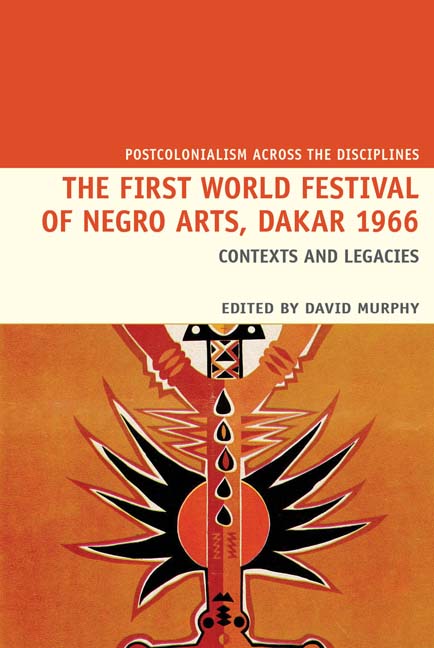Book contents
- Frontmatter
- Contents
- Acknowledgements
- List of Figures
- Notes on Contributors
- Introduction. The Performance of Pan-Africanism: Staging the African Renaissance at the First World Festival of Negro Arts
- I Contexts
- II Legacies
- 6 ‘Negritude is Dead’: Performing the African Revolution at the First Pan-African Cultural Festival (Algiers, 1969)
- 7 Beyond Negritude: Black Cultural Citizenship and the Arab Question in FESTAC ‘77
- 8 Cultural Festivals in Senegal: Archives of Tradition, Mediations of Modernity
- 9 FESMAN at 50: Pan-Africanism, Visual Modernism and the Archive of the Global Contemporary
- 10 PANAFEST: A Festival Complex Revisited
- Books and Films about the 1966 Festival
- Bibliography
- Index
10 - PANAFEST: A Festival Complex Revisited
from II - Legacies
- Frontmatter
- Contents
- Acknowledgements
- List of Figures
- Notes on Contributors
- Introduction. The Performance of Pan-Africanism: Staging the African Renaissance at the First World Festival of Negro Arts
- I Contexts
- II Legacies
- 6 ‘Negritude is Dead’: Performing the African Revolution at the First Pan-African Cultural Festival (Algiers, 1969)
- 7 Beyond Negritude: Black Cultural Citizenship and the Arab Question in FESTAC ‘77
- 8 Cultural Festivals in Senegal: Archives of Tradition, Mediations of Modernity
- 9 FESMAN at 50: Pan-Africanism, Visual Modernism and the Archive of the Global Contemporary
- 10 PANAFEST: A Festival Complex Revisited
- Books and Films about the 1966 Festival
- Bibliography
- Index
Summary
Introduction
The goal of this chapter is to present succinctly an archive in the making: the PANAFEST Archive. Born of exchanges between scholars hailing from several disciplines (anthropology, history, history of art, political science), the Archive focuses on four Pan-African festivals of arts and culture that took place in the 1960s and 1970s. Three of these festivals are well known and while the fourth has attracted considerable attention, prior to the PANAFEST project it had not been considered as a Pan-African festival in its own right. The four festivals are: the First World Festival of Negro Arts (FESMAN, held in Dakar in 1966); the First Pan-African Cultural Festival (PANAF, Algiers 1969); the Second World Festival of Black Art and Culture (FESTAC, Lagos 1977); and Zaïre ’74 (Kinshasa, 1974).
These four festivals tend to be addressed today by scholars and cultural actors according to a narrative scheme that sees in them a relatively clear and linear progression of events. FESMAN is perceived as the starting point of this teleology, followed by PANAF, which is read almost exclusively as a counter-FESMAN. Then comes FESTAC, understood as a synthesis of the two prior festivals. Zaïre ’74 is not mentioned, though there exist undeniable links between this event and the other three.
A reading that privileges linearity is certainly seductive. It constitutes, however, but one of many possible takes—one way among numerous others of understanding the relationship(s) between the four festivals. Other articulations can be proposed, which help excavate a more complex and far richer history of the events in question. The PANAFEST project seeks to highlight such complexity. Rather than a smooth narration, it offers a portrait of the four festivals that underscores their mutual entanglement.
From this focus on entanglement a picture emerges less of a series of festivals that followed one another than of a single, evolving event: one vast and shape-shifting festival that travelled across time and space. Considered from this vantage point, what looks initially like a simple progression leading from Dakar to Lagos comes to be seen instead as a sort of Mobius strip, folding over itself to produce multiple forms and meanings. Ideas, symbols and processes recur as the strip unfolds, taking on new appearances and significations.
- Type
- Chapter
- Information
- The First World Festival of Negro Arts, Dakar 1966Contexts and legacies, pp. 204 - 212Publisher: Liverpool University PressPrint publication year: 2016

